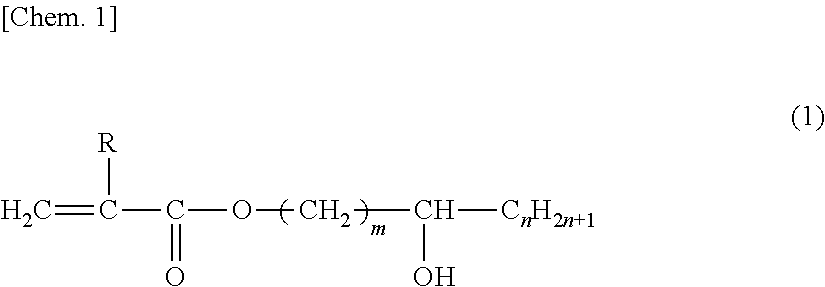Coating composition and method for forming coating film
a coating composition and coating film technology, applied in the field of coating compositions, can solve the problems of unsatisfactory acid resistance and unsatisfactory scratch resistance of the coating film, and achieve the effects of excellent finish appearance, moderate curability, and excellent balance of scratch resistance and stain resistan
- Summary
- Abstract
- Description
- Claims
- Application Information
AI Technical Summary
Benefits of technology
Problems solved by technology
Method used
Image
Examples
examples
[0170]Hereunder, the present invention is explained in more detail with reference to Examples and Comparative Examples. However, the present invention is not limited to the following Examples. In the following examples, parts and percentages are by mass, and the film thickness is the thickness of a cured coating film.
Production of Acrylic Resin (A)
production examples 1-9
[0171]31-part quantities of ethoxyethyl propionate were introduced into four-necked flasks, each equipped with a stirrer, a thermometer, a condenser tube, and a nitrogen gas inlet, and the resulting mixtures were heated to 155° C. under a nitrogen atmosphere. When the temperature reached 155° C., the supply of nitrogen gas was stopped, and each monomer mixture comprising a composition containing the monomers and the polymerization initiator shown in Table 1 below was added thereto dropwise over 4 hours. Subsequently, aging was performed for 2 hours under a nitrogen atmosphere at 155° C., and each of the resulting products was then cooled to 100° C., followed by dilution with 32.5 parts of butyl acetate. Thereby, acrylic resins (A-1) to (A-9), each having a solids content of 60%, were obtained. Table 1 below shows the solids mass concentration (%) and resin properties of the obtained acrylic resins (A).
[0172]In Table 1, the glass transition temperature (Tg (° C.)) was calculated usin...
production example 10
[0176]A 93-part quantity of heptane and 98 parts of the 55% polymeric dispersion stabilizer solution (Note 1) below were introduced into a four-necked flask equipped with a stirrer, a thermometer, a condenser tube, and a nitrogen gas inlet, and the resulting product was heated under reflux. The mixture of the monomers and the polymerization initiator shown below was added thereto dropwise over 3 hours, and the resulting product was aged for another 2 hours. Thereby, a non-aqueous dispersion-type acrylic resin (C-1) was obtained.
[0177]A Mixture of Monomers and a Polymerization Initiator
[0178]A mixture containing 15 parts of styrene, 40 parts of methyl methacrylate, 30 parts of acrylonitrile, 15 parts of 2-hydroxyethyl methacrylate, and 1.5 parts of t-butylperoxy-2-ethylhexanoate.
[0179]The thus-obtained non-aqueous dispersion-type acrylic resin (C-1) was a stable, milk-white, low-viscosity polymer dispersion having a mass solids concentration of 53%, a Gardner viscosity of B, and an a...
PUM
| Property | Measurement | Unit |
|---|---|---|
| mass % | aaaaa | aaaaa |
| hydroxyl value | aaaaa | aaaaa |
| hydroxyl value | aaaaa | aaaaa |
Abstract
Description
Claims
Application Information
 Login to View More
Login to View More - R&D
- Intellectual Property
- Life Sciences
- Materials
- Tech Scout
- Unparalleled Data Quality
- Higher Quality Content
- 60% Fewer Hallucinations
Browse by: Latest US Patents, China's latest patents, Technical Efficacy Thesaurus, Application Domain, Technology Topic, Popular Technical Reports.
© 2025 PatSnap. All rights reserved.Legal|Privacy policy|Modern Slavery Act Transparency Statement|Sitemap|About US| Contact US: help@patsnap.com



